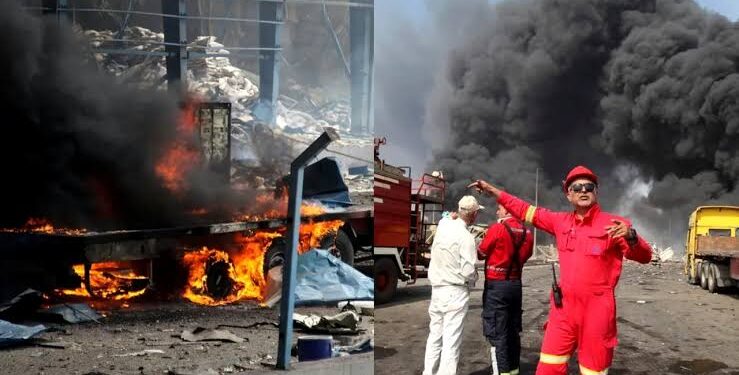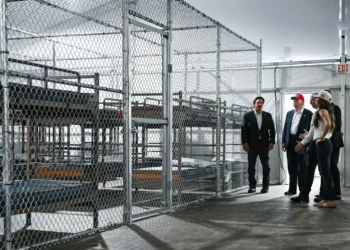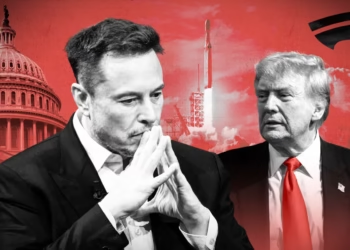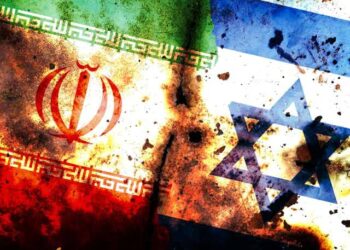The Middle East is on the brink of a larger conflict. The recent escalation between Israel and Iran has heightened tensions in the region.
On October 26, Israel struck approximately 20 Iranian military sites across three provinces, marking a significant escalation. This move has brought the region closer to a broader conflict.

The situation remains volatile, with tensions surge in the middle east as the international community watches closely. The potential for further escalation is high, and the impact on regional stability is significant.
The Current Crisis Unfolding Across the Middle East
A complex web of conflicts is unfolding across the Middle East, marked by recent explosions in Iran and intensified strikes in Gaza. The situation remains volatile, with both sides engaging in a dangerous escalation that complicates the prospects of defusing or ending the broader array of conflicts that pit Israel against Iran and its “Axis of Resistance.”
Timeline of Critical Events in the Past Week
Over the past week, several critical events have unfolded in the region:
- An explosion occurred in Iran, causing significant damage and heightening tensions.
- Renewed strikes in Gaza have led to increased casualties and infrastructure damage.
- Military movements and retaliatory actions have been reported from both Israel and Iran.
Strategic Importance of Recent Developments
The recent developments hold significant strategic importance, particularly in terms of regional power dynamics and immediate security concerns.
Shift in Regional Power Dynamics
The escalation amid Iran explosion and Gaza attacks signals a potential shift in regional power dynamics. This could lead to a realignment of alliances and an increase in military preparedness among the involved nations.
| Country | Military Response | Diplomatic Stance |
|---|---|---|
| Israel | Heightened military alertness | Condemnation of Iran’s actions |
| Iran | Retaliatory missile strikes | Accusations against Israel |
| Gaza | Continued resistance | Calls for international intervention |
Immediate Security Concerns
The immediate security concerns revolve around the potential for further escalation. The international community is on high alert, with key players urging restraint and calling for de-escalation measures to prevent a wider conflict.
Massive Explosion in Iran, Renewed Gaza Strikes Mark Turbulent Week in Middle East
A turbulent week in the Middle East has been marked by a devastating explosion in Iran and intensified attacks on Gaza. The region is witnessing a significant escalation in tensions, with far-reaching implications for global stability.
Details of the Iranian Explosion
The explosion in Iran has been a major point of concern, with various analyses attempting to understand its cause and impact. Key aspects include:
Location and Target Analysis
The explosion occurred at a critical military facility, raising questions about the target and the perpetrator. Initial assessments suggest that the site was involved in Iran’s military research and development.
Official Iranian Statements
Iranian officials have issued statements condemning the attack, pointing fingers at Israel as the likely culprit. The rhetoric has been heated, with promises of retaliation.
Latest Wave of Strikes in Gaza
Simultaneously, Gaza has faced renewed strikes, exacerbating the humanitarian situation. The military operations have targeted various locations, leading to significant damage.
Military Objectives Claimed
The military has claimed that the strikes were aimed at disrupting militant infrastructure and capabilities. However, the effectiveness of these operations is a subject of debate.
Civilian Infrastructure Affected
Reports indicate that civilian infrastructure, including residential areas and essential services, have been impacted. This has raised concerns about the humanitarian toll of the conflict.

Casualty Reports and Infrastructure Damage
The humanitarian impact of these events is significant, with reports indicating a substantial number of casualties and extensive infrastructure damage.
- Approximately 3 million people across Israel, Gaza, and Lebanon have been displaced.
- Iran has reportedly fired at least 180 missiles into Israel, escalating the conflict further.
- Civilian casualties in Gaza have been high, with infrastructure suffering considerable damage.
The situation remains volatile, with ongoing military operations and counter-operations likely to continue the cycle of violence.
Key Players and Their Strategic Objectives
As tensions surge in the Middle East, it’s essential to identify the primary entities driving the conflict. The current crisis involves several key players, including Iran, Israel, Hamas, and Hezbollah, each with its own strategic objectives and military capabilities.
Iran’s Position and Military Capabilities
Iran has been a significant player in the region, backing various militias and resistance groups. Its military capabilities include a substantial arsenal of ballistic missiles and a network of proxy forces across the Middle East.
Israel’s Security Concerns and Tactical Approach
Israel’s primary concern is maintaining national security against perceived threats from Iran and its proxies. Israel has adopted a proactive military stance, conducting airstrikes against Iranian targets and allied militias.
Hamas and Palestinian Resistance Groups
Hamas, a key player in the Gaza Strip, has been involved in repeated conflicts with Israel. Supported by Iran, Hamas possesses a significant rocket arsenal and has been a focal point of recent escalations.
Hezbollah’s Involvement from Lebanon
Hezbollah, another Iran-backed militia, operates from Lebanon and has been engaged in cross-border exchanges with Israel.
Cross-border Exchanges
These exchanges have heightened tensions, with both sides accusing each other of aggression. The situation remains volatile, with the potential for miscalculation.
Potential for Expanded Conflict
The involvement of Hezbollah and other militias raises concerns about the potential for an expanded conflict, drawing in more regional actors and complicating diplomatic efforts to de-escalate tensions.

International Diplomatic Responses
As the situation in the Middle East continues to deteriorate, global powers are responding with a mix of diplomatic efforts and military posturing. The recent explosion in Iran and renewed strikes in Gaza have heightened tensions, prompting a range of reactions from key international players.
United States’ Position and Military Movements
The United States has been increasing its military presence in the Middle East as part of its “deterrence” strategy against Iran. This move is seen as a demonstration of the U.S. commitment to regional security and stability. The deployment of additional troops and military assets aims to deter further escalation.
The U.S. administration has been in close communication with regional allies, discussing strategies to address the crisis. Diplomatic channels are being utilized to convey the importance of restraint and the need for de-escalation.
European Union’s Calls for Restraint
The European Union has issued a statement calling for restraint from all parties involved in the conflict. EU officials emphasize the need for diplomatic solutions to prevent further violence and destabilization in the region. The EU’s diplomatic efforts focus on encouraging dialogue and negotiation.
European leaders are working closely with other global partners to coordinate a unified international response. The aim is to promote peace and stability through collective diplomatic pressure.
Arab Nations’ Divided Stances
Arab nations have adopted varied positions in response to the crisis. Some countries have expressed support for Palestinian groups, while others have aligned themselves with the U.S. and its allies. This division reflects the complex geopolitical landscape of the region.
The differing stances among Arab nations highlight the challenges in achieving a unified regional response to the crisis. Diplomatic efforts are underway to bridge these divides and foster a more cohesive approach.
United Nations Security Council Deliberations
The United Nations Security Council has convened to discuss the escalating situation in the Middle East. Members are debating potential resolutions to address the crisis, with a focus on promoting peace and reducing violence. The UN’s role is crucial in providing a global platform for dialogue.
The Security Council’s deliberations are expected to influence international responses to the crisis, potentially shaping the course of diplomatic efforts in the region.

Economic and Strategic Implications of Middle East Instability
The ongoing conflict in the Middle East has triggered significant economic and strategic repercussions globally. The region’s instability affects not only the local economies but also has far-reaching consequences for global trade, security, and energy markets.
Global Oil Market Fluctuations
The conflict has led to concerns about the stability of oil supplies from the region. As a result, global oil prices have experienced significant fluctuations. The impact on oil markets is a critical concern for economies worldwide, particularly for those heavily reliant on oil imports.
Shipping and Trade Route Disruptions
The escalation of violence has disrupted shipping and trade routes, particularly in the Red Sea and the Strait of Hormuz. These waterways are crucial for international trade, and any disruption can have significant economic implications.
Red Sea Security Concerns
The Red Sea is a vital route for global trade, with a significant volume of goods passing through it. Security concerns in this region can lead to increased shipping costs and delays.
Strait of Hormuz Tensions
The Strait of Hormuz is another critical waterway that has been affected by the tensions in the region. Any disruption here can have severe implications for global oil supplies and prices.

Defense Industry and Arms Sales Surge
The ongoing conflict has led to an increase in defense spending and arms sales in the region. Countries are seeking to enhance their military capabilities in response to the heightened tensions.
| Region | Impact on Oil Prices | Shipping Disruptions |
|---|---|---|
| Red Sea | Moderate | High |
| Strait of Hormuz | High | Very High |
| Gaza | Low | Moderate |
The economic and strategic implications of the Middle East instability are far-reaching, affecting global oil markets, shipping routes, and defense industries. Understanding these implications is crucial for navigating the complexities of the conflict and its global impact.
Historical Context of Current Tensions
To comprehend the complexity of the current Middle East crisis, it’s essential to examine the historical backdrop of the Iran-Israel shadow war and the Gaza conflict. The hostilities between Israel and Iran date back to Iran’s 1979 revolution, setting the stage for decades of proxy wars, diplomatic tensions, and military confrontations.
Iran-Israel Shadow War Timeline
The Iran-Israel shadow war has its roots in the geopolitical shifts following the 1979 Iranian Revolution. Initially, Iran was a key ally to Israel, but the revolution transformed Iran into a theocratic state hostile to Israel. Over the years, this animosity has manifested in various ways, including:
- Proxy wars in Lebanon and Syria
- Cyberattacks on Israeli infrastructure
- Military strikes on Iranian nuclear facilities
Gaza Conflict Evolution Since 2007
The Gaza conflict has undergone significant evolution since 2007, marked by:
| Year | Event | Impact |
|---|---|---|
| 2007 | Hamas takeover of Gaza | Escalation of rocket attacks on Israel |
| 2008-2009 | Operation Cast Lead | Significant civilian casualties in Gaza |
| 2014 | Operation Protective Edge | Extensive destruction and loss of life in Gaza |
Nuclear Program Disputes and International Agreements
Iran’s nuclear program has been a contentious issue, with international efforts to curb its nuclear ambitions. The Joint Comprehensive Plan of Action (JCPOA) in 2015 was a significant attempt to address these concerns, but the US withdrawal in 2018 and reimposition of sanctions have complicated the situation.

Previous Cycles of Escalation and De-escalation
The Middle East has witnessed multiple cycles of escalation and de-escalation, with various factors contributing to these dynamics. Understanding these cycles is crucial for predicting future conflicts and identifying opportunities for peace.
The region’s complex history, marked by periods of relative calm punctuated by outbreaks of violence, underscores the need for a nuanced approach to conflict resolution.
Humanitarian Crisis and Civilian Impact
The Middle East conflict has triggered a massive humanitarian emergency, with far-reaching consequences for the civilian population. The recent escalation of violence has led to significant human suffering, with millions affected by the crisis.
Gaza’s Deteriorating Conditions
The situation in Gaza is particularly dire, with the local infrastructure struggling to cope with the demands of the crisis. The impact on civilians is severe, with many facing dire circumstances.
Medical System Collapse
The medical system in Gaza is on the brink of collapse, with hospitals facing shortages of essential supplies and medical personnel being overwhelmed by the influx of casualties. The collapse of the medical system has severe implications for the health and well-being of the civilian population.
Food and Water Shortages
The conflict has also led to shortages of food and water, exacerbating the humanitarian crisis. Civilians are struggling to access basic necessities, leading to a significant deterioration in living conditions.
| Category | Pre-Crisis | Current Status |
|---|---|---|
| Food Availability | Adequate | Severe Shortages |
| Medical Supplies | Sufficient | Critical Shortages |
| Water Access | Available | Limited Access |
Displacement and Refugee Concerns
The conflict has resulted in significant displacement, with approximately 3 million people forced to flee their homes. The humanitarian crisis is further complicated by the presence of refugees, who are in dire need of assistance.

International Aid Efforts and Blockades
International aid efforts are underway to alleviate the humanitarian crisis, but are being hindered by blockades and logistical challenges. The effectiveness of these efforts is crucial in determining the outcome of the crisis.
Psychological Trauma and Long-term Social Effects
The conflict is also having a profound psychological impact on civilians, particularly children. The long-term social effects of the crisis are likely to be significant, with potential lasting impacts on the social fabric of the affected communities.
The humanitarian crisis in the Middle East, particularly in Gaza, is a pressing concern that requires immediate attention and action. The international community must work together to address the crisis and mitigate its effects on civilians.
Potential Pathways to De-escalation
As tensions surge in the Middle East, finding a pathway to de-escalation becomes increasingly crucial. The recent events have highlighted the need for a multifaceted approach to reduce hostilities and work towards sustainable peace.
Current Ceasefire Negotiations
Diplomatic efforts are underway to negotiate a ceasefire between the conflicting parties. Two long-sought diplomatic deals might help ease the context of hostilities in the short term. These negotiations are critical in creating a conducive environment for further dialogue.
Regional Mediators and Their Proposals
Regional mediators, including Qatar and Egypt, have been actively involved in proposing solutions to de-escalate the conflict.
Qatar’s Diplomatic Role
Qatar has been pursuing diplomatic channels to facilitate dialogue between the parties involved. Their efforts have been instrumental in maintaining communication lines.
Egypt’s Border Management Efforts
Egypt’s role in managing the border and facilitating humanitarian aid has been crucial. Their efforts have helped in reducing the humanitarian impact of the conflict.
International Pressure Points and Incentives
The international community is applying pressure on the conflicting parties to de-escalate. Economic incentives and diplomatic support are being offered to encourage cooperation.
| Country | Role in De-escalation | Potential Impact |
|---|---|---|
| Qatar | Diplomatic Mediator | High |
| Egypt | Border Management | Significant |
| United States | Economic Incentives | Substantial |
Requirements for Sustainable Peace
Achieving sustainable peace requires addressing the underlying issues driving the conflict. This includes negotiations on key disputes and the implementation of long-term solutions.

The pathway to de-escalation is complex and requires the cooperation of all parties involved. With continued diplomatic efforts and international support, there is hope for a more peaceful future in the region.
Conclusion: Navigating an Uncertain Future in the Middle East
The situation in the Middle East remains precarious amid Iran explosion and Gaza attacks, with the risk of further escalation looming large. The recent surge in tensions has underscored the complexities of the conflict, involving multiple key players with divergent strategic objectives.
As the international community watches, diplomatic efforts continue to be crucial in preventing a wider conflict. The United States, European Union, and Arab nations have all played significant roles in calling for restraint, while the United Nations Security Council deliberates on a unified response.
The humanitarian crisis in Gaza continues to deteriorate, with displacement and refugee concerns mounting. The need for sustainable peace is evident, but the path forward is fraught with challenges. Regional mediators are working on ceasefire negotiations, and international pressure points are being leveraged to encourage de-escalation.
Ultimately, navigating this uncertain future will require sustained diplomatic engagement and a commitment to addressing the underlying issues driving the conflict amid Iran explosion and Gaza attacks.
FAQ
What are the main causes of the current tensions in the Middle East?
The current tensions in the Middle East are primarily driven by the escalating conflict between Iran and Israel, as well as the ongoing issues in Gaza, including the recent explosion in Iran and renewed strikes in Gaza.
How have the recent events in Iran and Gaza affected the regional power dynamics?
The recent explosion in Iran and the renewed strikes in Gaza have significantly impacted the regional power dynamics, heightening tensions between Iran and Israel, and raising concerns about the potential for expanded conflict involving other key players such as Hamas and Hezbollah.
What is the international community’s response to the current crisis in the Middle East?
The international community, including the United States, European Union, Arab nations, and the United Nations Security Council, has responded with various diplomatic efforts, calling for restraint and attempting to mitigate the conflict, with differing degrees of success.
What are the economic implications of the instability in the Middle East?
The instability in the Middle East has significant economic implications, including fluctuations in global oil markets, disruptions to shipping and trade routes, and a surge in the defense industry and arms sales, affecting not just the region but the global economy.
What is the humanitarian situation in Gaza amidst the current conflict?
The humanitarian situation in Gaza is dire, with deteriorating conditions, significant displacement and refugee concerns, and a substantial impact on civilians, necessitating international aid efforts to alleviate the suffering and address the long-term social effects.
Are there any ongoing efforts to achieve a ceasefire or de-escalation in the conflict?
Yes, there are ongoing ceasefire negotiations, with regional mediators proposing various solutions, and international pressure being applied to the parties involved, aiming to achieve a sustainable peace and reduce the violence.
How have the recent events affected global security concerns?
The recent events have heightened global security concerns, particularly in critical waterways such as the Red Sea and the Strait of Hormuz, due to the potential for disruptions and the escalation of the conflict.
What is the historical context of the Iran-Israel conflict?
The Iran-Israel conflict has a complex history, involving a shadow war, disputes over Iran’s nuclear program, and previous cycles of escalation and de-escalation, which are crucial to understanding the current tensions.





















































